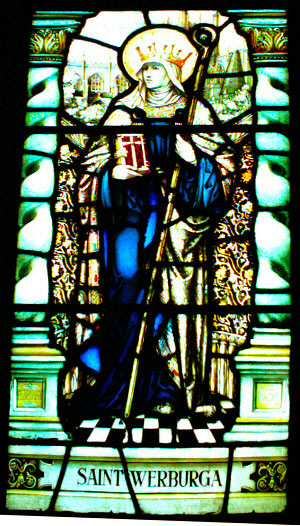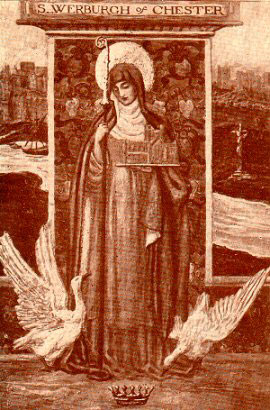 |  | |
|
Home |
Hotels | Guest Houses |
Chester Events |
Visiting Chester |
Parking |
Shopping |
Business |
Chester Pubs |
Restaurants |
Tickets |
Chester Live! |
Community |
Contact Us |

|
|
|
|
|
 |
News
Chester Cathedral
Sunday 4th February 2024
Feast of St Werburgh
Live Stream https://www.youtube.com/watch?v=WDayhaEIKB8

3rd February 2024 is the Feast of St Werburgh, the patron saint of Chester. She was an Anglo-Saxon princess who became a nun.
Her remains were brought to Chester for safety during an invasion by the Danes in 875, and the remains of her shrine can be found in the Cathedral’s Lady Chapel.
Tomorrow’s Cathedral Eucharist will celebrate the life of St Werburgh.
Miracles surrounding St Werburgh which supported her canonisation (being made a saint) include her body being found uncorrupted when it was relocated to Hanbury.
The most famous story demonstrating Werburgh's miraculous powers concerned her flock of tame geese. When one of the birds was cooked and eaten by a servant.
The remainder of the flock came to Werburgh who retrieved the bones of the butchered goose and restored it to life.
The relics of St Werburgh at St Werburgh's Abbey and, later, Chester Cathedral became a focal point for pilgrims across medieval Europe.
Who received badges depicting a gaggle of geese as proof of their attendance.
All are welcome to join us Sunday 4th February 2024 10:30am, in the Cathedral or online, as we celebrate the life of St Werburgh.
The service will be streamed on our official YouTube channel
https://www.youtube.com/watch?v=WDayhaEIKB8
The life of St. Werburgh

Chester Cathedral
Sunday 4th February 2024
Feast of St Werburgh
Live Stream https://www.youtube.com/watch?v=WDayhaEIKB8

3rd February 2024 is the Feast of St Werburgh, the patron saint of Chester. She was an Anglo-Saxon princess who became a nun.
Her remains were brought to Chester for safety during an invasion by the Danes in 875, and the remains of her shrine can be found in the Cathedral’s Lady Chapel.
Tomorrow’s Cathedral Eucharist will celebrate the life of St Werburgh.
Miracles surrounding St Werburgh which supported her canonisation (being made a saint) include her body being found uncorrupted when it was relocated to Hanbury.
The most famous story demonstrating Werburgh's miraculous powers concerned her flock of tame geese. When one of the birds was cooked and eaten by a servant.
The remainder of the flock came to Werburgh who retrieved the bones of the butchered goose and restored it to life.
The relics of St Werburgh at St Werburgh's Abbey and, later, Chester Cathedral became a focal point for pilgrims across medieval Europe.
Who received badges depicting a gaggle of geese as proof of their attendance.
All are welcome to join us Sunday 4th February 2024 10:30am, in the Cathedral or online, as we celebrate the life of St Werburgh.
The service will be streamed on our official YouTube channel
https://www.youtube.com/watch?v=WDayhaEIKB8
The life of St. Werburgh


St Werburgh (or Waerburh) was the daughter of King Wulfhere of Mercia (657 - 674). Her mother was St. Ermenilda, daughter of King Ercombert of Kent. It is not known when St. Werburgh was born. She became a nun at Ely. And later directed other Mercian monasteries. She did not have any associations with Chester during her lifetime.


One legend associated with St Werburgh is the legend of the wild geese. One day on her fathers estates in Weedon, Northamptonshire. A flock of wild geese came down and were eating all the crops.
St Werburgh instructed a servant to collect the birds. The flock was collected and instructed to go to St Werburgh, which they all did. They were instructed to leave the land and not to come back. As the geese flew off, they noticed that one was missing. The servant had killed one bird to eat. St Werburgh restored the bird to life from the bones. The bird was released, and flock flew off and they were not seen again.
This legend is celebrated in a stained glass window at Weedon Bec, Northamptonshire. And also in a representation on a mistercord in Chester Cathedral choir (shown below). There is also a St. Werburgh's in Dublin.
![]() Click here to see the Miserichord
Click here to see the Miserichord

The death of St. Werburgh
St Werburgh died in 699 and was buried in Hanbury in Staffordshire. Nine years she was disinterred at the command of Ceolred king of Mercia (709 - 716). Her body and clothes were found to be intact, a sure sign of a saint. She was placed in a display coffin. But when the Danish invasions started her remains were transferred to Chester in 875, for safekeeping. By this time the coffin was lost and the remains were now just dust and bone. Her remains were placed in a casket.
In days of old, the casket was brought out in times of danger to protect Chester. When the Welsh were besieging Chester. The casket was lifted onto the battlements of the walls. The Welsh king Gruffydd saw the casket and was struck blind.
St Werburgh's feast day is on the 3rd of February.
Her translation is celebrated on the 21st June.
Pilgrimage and the Shrine of St. Werburgh


About 1300 a carved shrine was made to house the casket. It had a feretory were the remains were placed. Below this carved stone niches were pilgrims placed offerings and prayed. At the top are 34 carved figures representing the kings and saints of Mercia, Including:
King Crieda (founder of Mercia),
King Penda (632 - 654 Werburgh's grant father),
King Wulfhere,
King Ceolred,
King Offa (757 - 796)

During the reformation in the 16th century the shrine was smashed up and the heads of the Mercian king cut off. The remaining parts were incorporated in the bishop's seat or 'cathedra'. In 1876 some of the pieces were collected together and the shrine was reconstructed. The result is what you can see today.
Detail from the right hand side of the shrine is a dog scratching his ear.


More about St. Werburgh from the Catholic Encyclopedia Back to Visiting Chester Chester Tourist - Chester Cathedral
External Links

![]() St Werburgh, the patron saint of Chester from Wikipedia
St Werburgh, the patron saint of Chester from Wikipedia
![]() The Life of St Werbergh
The Life of St Werbergh
![]() The Life of St Werbergh
The Life of St Werbergh
![]() St Werberga and her royal and saintly relatives at Ely
St Werberga and her royal and saintly relatives at Ely
![]() Reference to Earl Hugh building the abbey church
Reference to Earl Hugh building the abbey church
![]() Early British Kingdoms: St. Werburga of Chester, Abbess of Ely
Early British Kingdoms: St. Werburga of Chester, Abbess of Ely
![]() Anselm Archbishop of Canterbury 1093–1109 from Wikipedia
Anselm Archbishop of Canterbury 1093–1109 from Wikipedia
![]() Catholic Encyclopedia: St. Anselm
Catholic Encyclopedia: St. Anselm
![]() The Minerva Shrine
The Minerva Shrine
The Sacred Sites and Pilgrimage WebRing. To browse visit Here
This page was last updated





